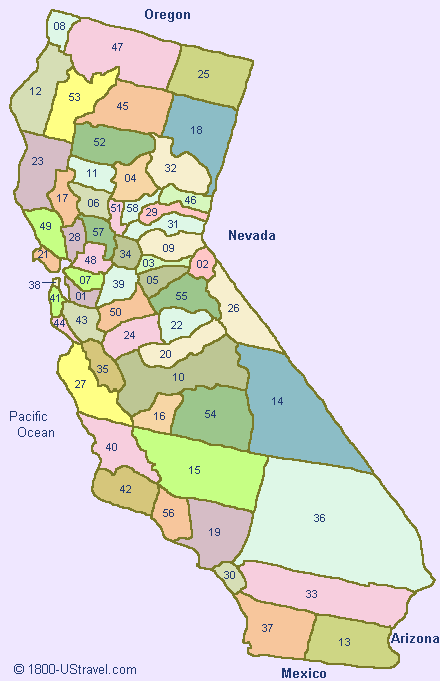Counties in California: Full 58-County Guide with Interactive Map
Counties in California: Full 58-County Guide with Interactive Map
Blog Article

Trying to find out how many counties are in California? You’re not alone. Be it for research, a road-trip map, or pub-quiz glory, the answer—58—comes up again and again, and stillthat short answer barely scratches the surface.
California’s counties form an incredibly diverse mosaic: surf-washed beach cities, pine-covered mountain regions, vast agricultural heartlands, and global entertainment capitals. Each county carries its own story, forged through gold-rush dreams, high-tech revolutions, and ever-changing demographics.
In the sections ahead, we’ll explorethe timeline that locked the total at 58, what each county actually does for its residents, and the outliers that set fascinating records. By the end, you’ll know the facts—and map your next California adventure with confidence.
County-Making in Early California
On statehood day in 1850, the map was a patchwork of just 27 jurisdictions. An unprecedented population boom pushed officials to subdivide vast districts. Within twenty years, the count had expanded toward more than fifty counties, and by 1907 the last adjustments were ratified, cementing the canonical figure of fifty-eight.
Legislative records show that fresh jurisdictions sprang out of three overlapping forces:
- Geographic isolation made court access impossible.
- Tax disputes splitting river towns from hinterlands sparked break-ups.
- Cultural rivalries demanded tailored governance.
By 1920, the political map stabilised. Right now, no proposal to add a 59th county has cleared committee, prompting analysts to call the era of county making decisively over.
Landscape and Climate Diversity Across California Counties
Stretch a string from the Smith River watershed to border-side Calexico, and you’ll cross dozens of ecosystems. Pacific-facing districts benefit from Mediterranean precipitation, while great agricultural belts bank on irrigation.
- Alpine districts such as Mono, Mariposa, and Calaveras receive winter snows.
- Sacramento–San Joaquin fringe counties mix levee farms with wetlands.
- Channel-coast administrators like Ventura oversee ferry routes.
Such variety explains why no two counties share identical economies. Climate, after all, shapes crops and careers.
What Counties Actually Do
Amid Sacramento’s delegated framework, municipalities handle zoning, but county boards oversee the bread-and-butter functions that hold civilisation together. From birth to death—vital records, coroner reports, property deeds—all reside at the recorder-assessor’s office.
Sheriff’s departments patrol towns too small for police forces, while superior courts hear civil suits. Health departments distribute food assistance. Tax-allocation showdowns occur in monthly Board of Supervisors sessions.
Spotlight: Los Angeles County’s Scale
Contra Costa partners with nearby cities for animal control, showing how flexible county structures can be. One template doesn’t fit all when land areas shift from 47 to 20 000 sq mi.
Ultimately, county halls act as middle managers between Capitol and curbside. Understanding their remit helps residents demand accountability.
Demographic and Fiscal Highlights
The state shelters over thirty-nine million people, but the headcount is far from evenly spread. LA’s single jurisdiction packs nearly 25 %. At the other extreme, high-elevation Alpine rarely tops 1 200 inhabitants.
- Largest population: Los Angeles
- Smallest by residents: Alpine
- Biggest footprint: San Bernardino County
- Smallest area: City & County of SF
Fiscal bandwidth mirrors population spread. Tech-centric jurisdictions report six-figure median incomes, while interior ag counties depend on seasonal labour influxes. This revenue gap informs legislative redistricting every decade.
Tracking each superlativeis trivia gold: county borders redraw home-buying budgets and business licences.
An Epic 58-County Road Trip
For intrepid travellers, bagging all 58 jurisdictions has become number of counties in california a badge. The classic route kicks off in the south-west corner, rolls up the Pacific Coast Highway, jogs east near Santa Cruz, then zigzags across rice-field flats and orchard grids, before ascending into the Sierra Nevada for historic gold-rush hamlets.
Regional Mini-Loops
- Coastal Kick-off – Mission trail coast; a baker’s dozen of stops in a long weekend of days.
- Heartland Stretch – Grapes to rice paddies; produce-market run.
- Lava Beds Detour – mountain lakes and volcano cones; hidden hot springs.
Cap off the circuit in Imperial, having logged 1 400–2 000 miles. By then, you can answer any road-trip quiz about county tallies—because you’ve seen them all!
Frequently Asked Questions
Curious about California’s 58 counties? The following FAQ has you covered.
How many counties are in California?
State records confirm fifty-eight counties—a total locked in for over a century. Regardless of the source—be it Sacramento archives or federal census data: precisely fifty-eight.
Where do the most Californians live?
Los Angeles County tops the list, hosting a population greater than that of many U.S. states. Decades of immigration, entertainment dominance, and job growth keep the numbers high.
Which CA county has the fewest residents?
The crown for smallest population goes to Alpine County, rarely crossing the 1 200-resident mark. Its remote Sierra setting naturally restricts settlement, making it a haven for solitude seekers.
What is California’s biggest county geographically?
Geographic titan San Bernardino County covering a footprint larger than nine U.S. states. From Joshua trees to ski lifts, few regions illustrate California’s contrasts so vividly.
What historical events fixed the number at 58?
Gold-rush politics, rail expansion, and farmland disputes carved today’s boundaries, with the final adjustments ratified in 1907. Since then, proposals to add a 59th county have surfaced but never cleared the Legislature.
Could a region break away to become its own county today?
On paper, state statutes permit county formation, though the process is arduous. A break-off region must gather local signatures, win a majority vote in each affected county, and secure legislative approval. That’s why no county lines have moved since the early 1900s.
What services do California counties provide to residents?
Behind the scenes, counties keep daily life functioning: foster care, libraries, building permits, and superior courts. Remove counties from the equation, and civil society would struggle to operate.
Report this page